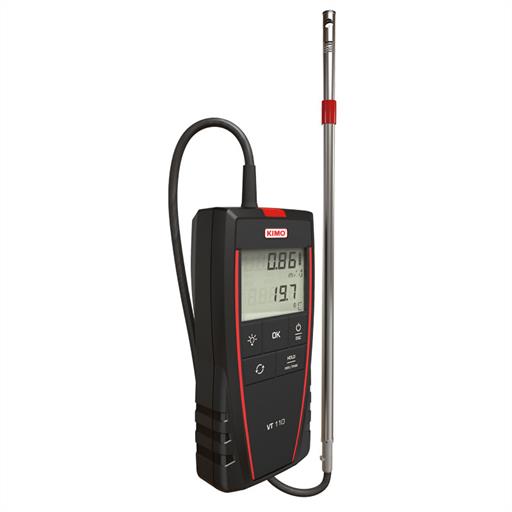An anemometer is a device used to measure wind speed for a variety of applications, including for sporting events and HVAC system troubleshooting and monitoring.
Finding the right anemometer for your specific needs can often be an arduous task. To help make things easier, this article outlines four main types of anemometers, provides some product examples, along with recommended applications.
Anemometer Applications
Householders, businesses, and professionals commonly use anemometers for:
- Outdoor environmental monitoring
- HVAC monitoring
- Measuring wind velocity where the source is inconsistent; and
- Taking high-velocity measurements.
Types of Anemometers
Cup Anemometer
Cup anemometers generally consist of three cups attached to horizontal arms mounted on a vertical rod. As the wind velocity increases, the cups spin freely. A hall effect sensor or reed switch measures the number of rotations in a time frame and converts the rotation measurement into a wind speed metric.
Pole Mount Cup Anemometer
Product Code: Vortex-P-30
The Vortex-P-30 is a tough instrument designed to measure wind speed from 4.8-200 km/h. It is an inexpensive way to provide you with accurate wind speed in places where AC power may not be available.
Application: Built to measure outdoor wind speeds where accuracy is important, and AC power is lacking. Perfect for mounting on the roof of your home, business, or school.
Outstanding Features: Water-resistant indoor LCD screen, 1000 hour battery life, broad measurement range, mounting bracket included.
Wind Measurement Units: km/h, mph, Knots
Wind Measurement Range: 4.8-200km/h
Accuracy: 0.8 km/h from ~6.4 to 16 km/h ±4% from 16 to 80.4 km/h estimated within 4% above 80 km/h
Vane Anemometer
Vane anemometers measure wind speed using propellers or turbines. For example, a propeller blade may have a magnet that passes by a reed switch each time the turbine spins. The device measures each time the magnetised blade passes the reed switch within a specific timeframe and converts this to a windspeed measurement.
(Unlike cup anemometers) vane anemometers must be faced in the direction of a wind source to obtain accurate data.
Thermo-anemometer with 100mm vane probe
Product Code: LV110S
The LV110S is by far our most popular Vane Anemometer for HVAC systems! It features a 100mm wired probe, calculates airflow, automatically averages wind speed, and detects flow direction.
Application: This anemometer is perfect for HVAC systems, monitoring exhaust flow and, exhaust hoods
Outstanding Features: Conforms to EMC 2004/108/CE and EN 61010-1, is supplied with a 100mm vane
probe, and the coiled sensor cable makes for ease of use.
Wind Measurement Units: m/s, fpm,
km/h
Wind Measurement Range: 1.08 to 126 km/h
Accuracy: From 0.3 to 3 m/s : ±3% of reading (±0.1 m/s) From 3.1 to 35 m/s : ±1% of reading (±0.3 m/s)
Hot Wire Anemometer
Hot Wire Anemometers measure wind speed using the principle that the colder impact of wind flow extracts heat. They use a fine wire heated a few degrees above the ambient temperature. The device will try and keep the wire at a constant temperature while any air flowing past will start to cool it. The meter will then measure how much current was needed to keep the wire at a constant temperature and simultaneously convert this metric to an air velocity reading.
Thermo-anemometer with hotwire
Product Code: VT110S
The VT110S Hot Wire Anemometer can measure air velocity, temperature, and airflow. Packed with features including airflow calculation, automatic average, detection of flow direction and, hold/minimum/maximum functions, the VT110S makes wind velocity measurements easy.
Application: Areas with relatively constant temperature such as indoor environments checking flow hoods, HVAC systems, and exhaust monitoring.
Outstanding Features: Includes; data hold function, display of minimum and maximum values, airflow detection, dimensions of rectangular and circular ducts, automatic average, and air velocity compensation in atmospheric pressure.
Wind Measurement Units: m/s, fpm,
km/h
Wind Measurement Range: From 0.15 to 30
m/s
Accuracy: From 0.15 to 3 m/s : ± 3% of reading (± 0.05 m/s) From 3.1 to 30 m/s : ± 3% of reading (± 0.2 m/s)
Pitot Tube Anemometer
Pitot Tube Anemometers are suitable for measuring mid-range to high-velocity and temperature airflow. A pitot tube design generally has two holes. The first hole at the front faces the wind direction and measures stagnation pressure. The second hole is located on the side of the pitot tube and measures static pressure. The device calculates the difference between these two pressures to produce in a dynamic pressure reading, which converts to a wind velocity reading.
PitotTube Anemometer with Differential Manometer
Product Code: HD350
The HD350 Pitot Tube Anemometer with Differential Manometer measures air temperature, pressure, air velocity, and airflow. The unit also stores up to 99 readings in each category that you can transfer to a computer via a USB.
Application: We recommend the HD350 for high temperature, high wind velocity environments where airflow is constant, such as HVAC systems, exhaust vents, and flow hoods.
Outstanding Features: Simultaneous display of pressure, air velocity, or airflow plus temperature. Max/Min/Avg recording with Relative time stamp, USB connection, data hold, and Store/Recall up to 99 data points.
Wind Measurement Units: ft/min, m/s, km/hr, mph, and knots
Wind Measurement Range: 3.5 to 288km/hr
Air Velocity Accuracy: ±3%
rdg
Conclusion
There are four main types of anemometers to suit specific needs and applications. If you are searching for a device to measure wind speed, start narrowing down your options by determining what type of anemometer will best suit your needs.
Need help with any of the types listed above? Want more information on Anemometers? Contact one of the Instrument Choice Scientists. We’re here to help!
Call 1300 737 871 or email customer-service@instrumentchoice.com




